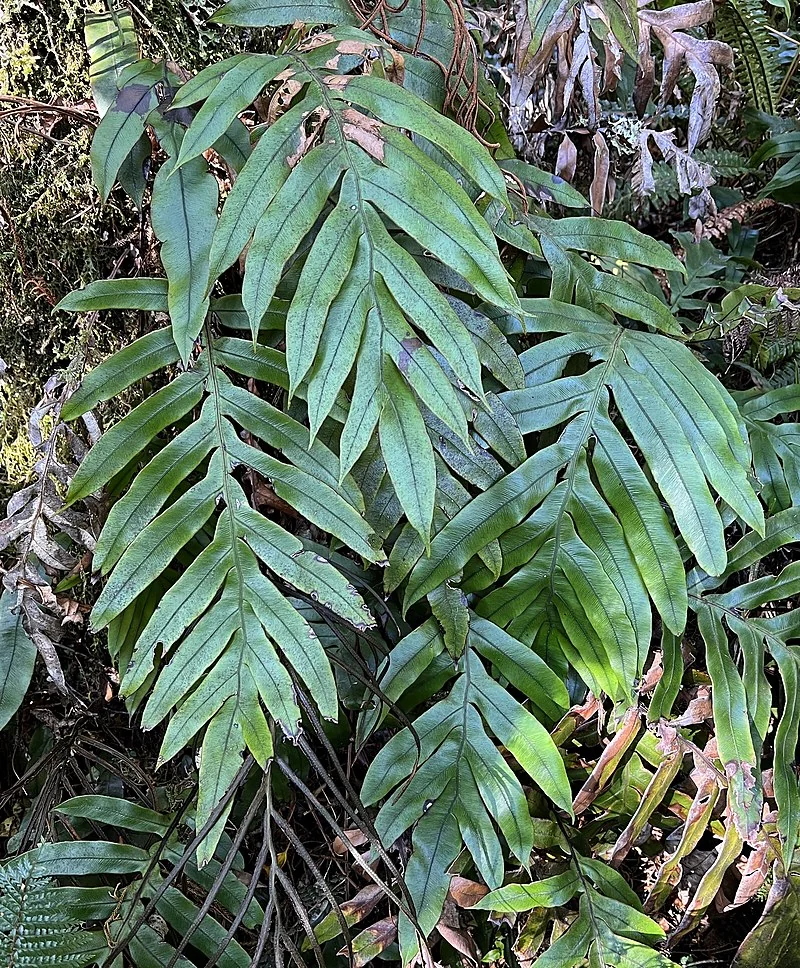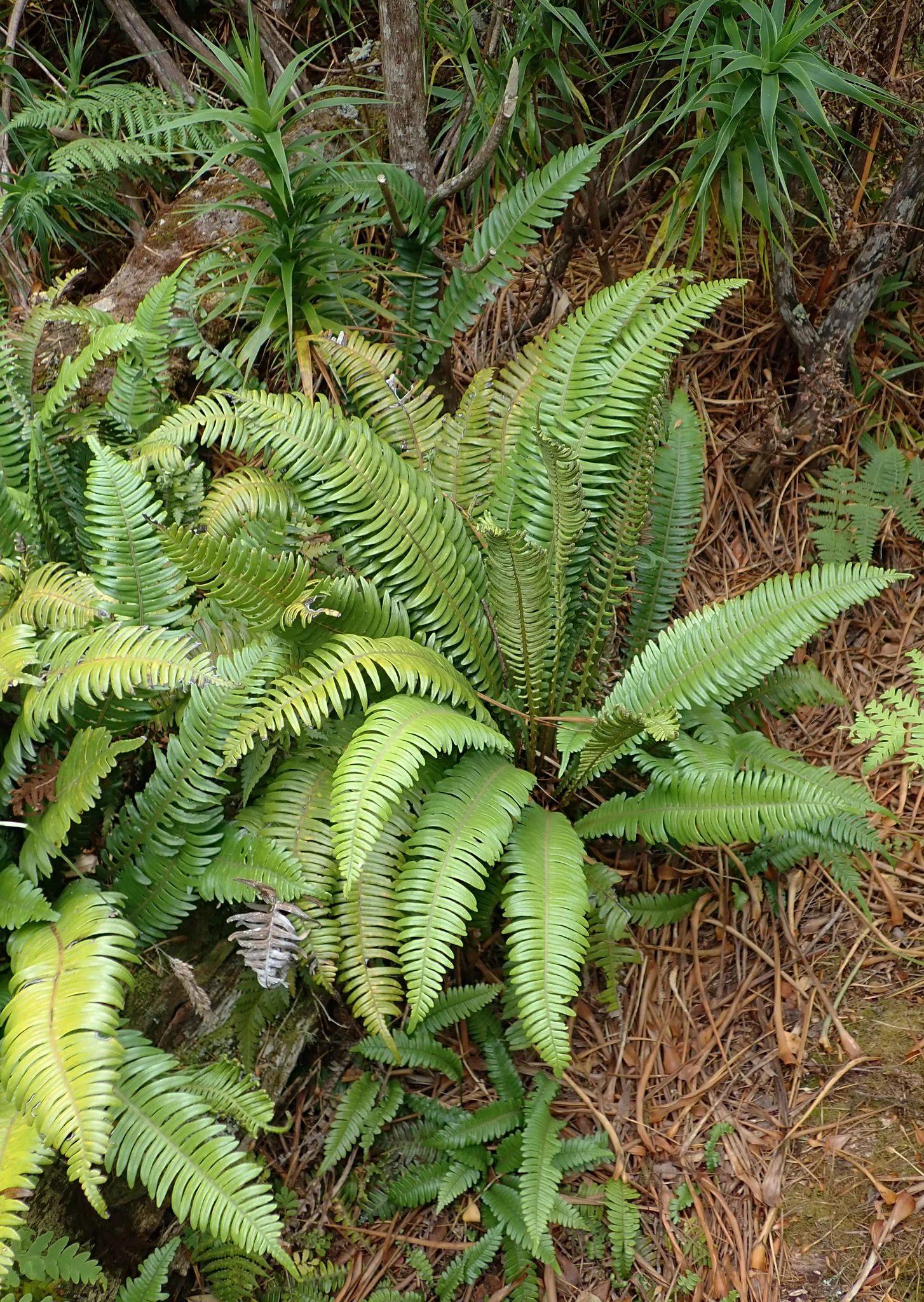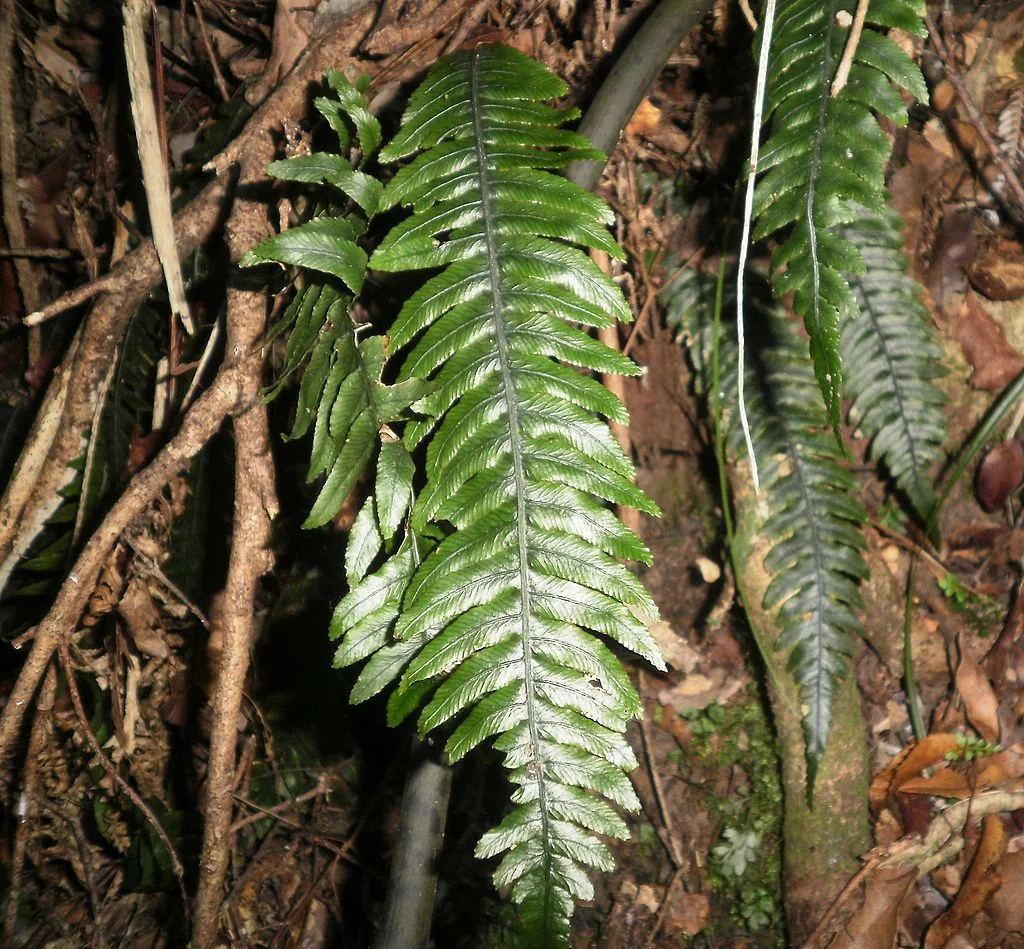
Colenso's Hard Fern
Austroblechnum colensoi
Austroblechnum colensoi , also known as Colenso's hard fern, waterfall fern, peretao, or petako, is a stout, evergreen fern native and endemic to New Zealand. It is found across the North, South, and Stewart Islands, as well as the Chatham and Auckland Islands. This fern typically thrives in damp, shaded environments, such as seepages on steep banks, rock overhangs, fringing river gorges, and sodden ground within cloud forests, ranging from coastal to montane areas. It prefers cool conditions and permanently moist soil, as it will not tolerate drying out.

Plant Description
Austroblechnum colensoi (Colenso's hard fern; syn. Blechnum colensoi ) forms erect clumps of leathery, ladder-like fronds to 1.2 m, with distinct sterile and fertile fronds; the fertile fronds are narrower with continuous sori.
Quick Facts
| Scientific Name | Austroblechnum Colensoi |
|---|---|
| Common Name | Colenso's hard fern, Waterfall fern, Peretao, Petako |
| Plant Type | Stout, evergreen fern |
| Fronds | Numerous, cartilaginous to coriaceous, up to 1 meter long (usually shorter), dark green to glaucous green above, paler beneath, narrow elliptic to almost rhomboid shape, undivided or irregularly divided |
| Rhizomes | Short-creeping, scaly |
| Stipes | 60-400 mm long, covered at base with dark red-black to black scales |
| Habitat | Damp, shaded environments, seepages on steep banks, rock overhangs, fringing river gorges, sodden ground within cloud forests (coastal to montane) |
| Distribution | North, South, and Stewart Islands, Chatham and Auckland Islands (endemic to New Zealand) |
| Conservation Status | Not Threatened (uncommon north of Auckland) |
| Cultivation | Difficult and very slow-growing |
| Height | Up to 1 m (usually shorter) |
| Spread | 60-80cm clumping spread |
| Growth Rate | Very slow |
| Water Needs | High - requires permanently moist soil |
| Light | Full shade to partial shade |
| Frost Tolerance | Moderate - hardy in cool temperate climates |
| Salt Tolerance | Low - not suitable for coastal exposure |
| Lifespan | Long-lived perennial (decades) |
| Climate Cities | Suitable for Wellington, Christchurch, Dunedin, Nelson, Hamilton |
| Etymology | Named after William Colenso |
Climate Best Suited to
Cool, humid mountain to lowland forest climates with year-round moisture and shelter. Tolerates light frost; dislikes drying winds.
Regional Suitability
| City | Climate Suitability |
|---|---|
| Whangārei | Ideal |
| Auckland | Ideal |
| Hamilton | Ideal |
| Tauranga | Ideal |
| Rotorua | Ideal |
| Gisborne | Ideal |
| New Plymouth | Ideal |
| Napier | Ideal |
| Whanganui | Ideal |
| Palmerston North | Ideal |
| Wellington | Ideal |
| Nelson | Ideal |
| Christchurch | Ideal |
| Dunedin | Ideal |
| Invercargill | Ideal |
Natural Habitat
Wet, Dark Places
Austroblechnum colensoi (Colenso's Hard Fern) is a specialist of dark, wet environments. It is typically found in deep gorges, on steep banks with constant seepage, near waterfalls, and in sodden ground within cloud forests. It ranges from coastal to montane zones but always where humidity is high and light is low.
Plant Conservation
Colenso's hard fern is widespread and currently not threatened nationally, but local populations can decline where riparian shade is lost or browsing pressure is high. Protect damp gullies from stock, goats and deer, retain canopy cover to maintain humidity, and control invasive weeds along streams. Restoration plantings that re‑establish shade and stable banks quickly favour this moisture‑loving species.
Growing Requirements
Soil
Permanently wet, cool soil. Thrives in clay or rocky ground with water seepage.
Light
Deep shade is essential. It is one of the most shade-loving native ferns.
Water
Very high. Cannot tolerate drying out. Best with constant moisture or trickle irrigation.
Planting Guide
Specialized Conditions
This fern is challenging to grow unless you can replicate its natural habitat: dark, cool, and wet. It is best suited for a specialized fernery, a deep gully, or a damp rock wall with water seep. Plant it low down where cool air settles and moisture collects.
Ecology
In cool, humid forest it forms bold clumps that intercept drip and slow overland flow, helping retain moisture on steep slopes. The persistent frond bases create refuges for amphipods and other litter invertebrates, while dense growth gives cover to skinks and ground‑foraging birds. Decaying fronds contribute fibrous humus that stabilises bank soils.
Uses
Excellent for anchoring the lower tier of shaded borders, underplanting along watercourses, and creating evergreen structure in fernery schemes. Use as repeated clumps to lead the eye along a path or to frame steps where filtered light keeps fronds lush through summer.
Landscaping Ideas
Layer behind finer ferns such as Hymenophyllum to contrast textures, and pair with glossy Pseudopanax or Griselinia for bold leaves. On shady banks, stagger groups to read as a continuous sweep that also slows runoff.
Seasonal Care
Summer
Maintain deep, even moisture and top up mulch to buffer heat.
Winter
In frost‑prone hollows, fleece young plants or provide overhead canopy protection.
Groom away old fronds in late winter and refresh leaf‑litter mulch annually to keep roots cool and active.
Pruning
Pruning Techniques
Cut spent or storm‑damaged fronds cleanly at the base before croziers emerge. Avoid hard cutting into the crown; staged tidying preserves the plant's layered habit and protects next season's growth.
How to Grow Colenso's Hard Fern
Colenso's Hard Fern grows best when you match its natural habitat: prepare well-drained soil, get the light right, water steadily, and protect from extremes during establishment. Dig wide planting holes, set the crown at original depth, water to settle, and mulch with coarse organic matter to conserve moisture while keeping the stem base dry. Feed lightly in spring; heavy nitrogen is unnecessary and can weaken growth.
Seed
Sow fresh, viable seed on a free-draining mix, cover lightly with fine grit, and keep evenly moist in bright light out of harsh sun. Germination timing varies; prick out once roots hold the media and harden off gradually.
Division
Where the species permits, divide robust clumps in early spring as new growth begins. Replant divisions with several shoots into fresh mix, water thoroughly, and maintain steady moisture until re"established.
Cuttings
For shrubs and many perennials, strike semi-hardwood cuttings in late spring to summer in a coarse, free-draining propagation mix under gentle bottom heat and high humidity. Reduce leaf area, ventilate progressively as roots develop, and pot on before planting out.
Aftercare
Maintain an open mulch, irrigate during drought in the first season, and prune or tidy according to the species to build a resilient framework. Adjust shade, wind exposure and watering to prevent stress, and refresh mulch annually for long-term performance.
Pests and Diseases
Common Problems and Solutions
Generally resilient in cool shade. Fresh croziers attract slugs and snails; use barriers or traps. In stale air, scale can settle on older fronds - improve airflow and treat with horticultural oil. Browning tips usually signal drought or excess sun; increase shade and irrigation accordingly.
Cultural Significance
This fern holds cultural importance for Māori, who know it by the traditional names peretao and petako. These names reflect the plant's significance in traditional ecological knowledge and its role in New Zealand's indigenous plant communities.
The species is named after William Colenso (1811-1899), a notable figure in New Zealand's natural history. Colenso was a Cornish Christian missionary to New Zealand who also distinguished himself as a printer, botanist, explorer, and politician. His extensive botanical collections and documentation of New Zealand's flora were instrumental in advancing scientific understanding of the country's unique plant life.
Bonus Tip
Expert Growing Advice
Mimic a forest floor: a generous, airy mulch of leaf litter and fine bark keeps soils cool and evenly moist, while a light over‑storey or shade cloth prevents scorch during summer northerlies.







